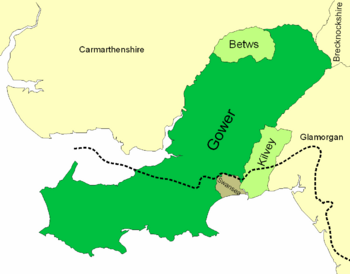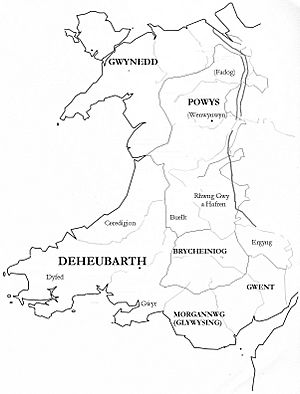Lordship of Gower facts for kids
Quick facts for kids
Lordship of Gower
Arglwyddiaeth Gŵyr
|
|||||||||||
|---|---|---|---|---|---|---|---|---|---|---|---|
| c. 1116–1536 | |||||||||||

Map of the Lordship, showing the area detached (Betws), the area added (Kilvey Lordship) and the Town and Franchise of Swansea. The language boundary is shown as a dotted line.
|
|||||||||||
| Status | Client state of the Kingdom of England | ||||||||||
| Capital | Swansea | ||||||||||
| Government | Lordship | ||||||||||
| Lord | |||||||||||
|
• 1158 - 1184
|
William de Newburgh | ||||||||||
|
• 1331 - 1354
|
John, Lord Mowbray | ||||||||||
|
• 1492
|
Somerset Lord Herbert | ||||||||||
| Historical era | Middle Ages | ||||||||||
| c. 1116 | |||||||||||
| 1536 | |||||||||||
|
|||||||||||
Gower was a special type of territory in South Wales during the Middle Ages. It was called a 'marcher lordship' because it was on the border, or 'march', between England and Wales. These lordships were like small, independent states ruled by powerful Norman lords. Gower was originally part of a Welsh kingdom called Deheubarth.
Contents
How Gower Became a Lordship
Before the Normans arrived, Gower was known as Gŵyr. It was a smaller area within a larger Welsh region. This region was often fought over by different Welsh rulers.
In 1088, Welsh princes attacked Deheubarth. The ruler, Rhys ap Tewdwr, eventually got his land back. But he was later killed fighting against a Norman lord named Bernard de Neufmarché.
After this, the English King Henry I started to take more control. He gave parts of Wales to different people. In 1106, King Henry I gave the area of Gower to Henry de Beaumont. Henry de Beaumont was an important English noble.
Henry de Beaumont built Swansea Castle to be the main base for his new lordship. Soon after, English-speaking people settled in the southern part of the Gower peninsula. This led to the area being divided into two parts: Welsh Gower and English Gower.
What Gower Looked Like
The Lordship of Gower was a territory bordered by several rivers. These rivers were the Loughor, Amman, Twrch, and Tawe.
The main town and castle of Gower was Swansea. The lordship stretched west to the end of the Gower Peninsula. It also went north towards places like Ystalyfera and Gwaun-Cae-Gurwen.
The Braose Family Takes Over
Later, the Lordship of Gower changed hands. In 1203, King John of England gave Gower to William III de Braose. William de Braose was a powerful Norman noble. He had to provide one knight for the king's service in return for the land.
The Braose family ruled Gower for many years. However, a small part of the lordship, the parish of Betws, was separated from Gower in the 1200s. The Braose family continued to hold Gower until 1326. At that time, the last Braose lord, William de Braose, died without any sons to inherit his lands.
Later Rulers and Changes
Before he died, William de Braose tried to decide who would get his lands. He planned to give Gower to his eldest daughter, Aline, and her husband, John de Mowbray. However, William also tried to sell the land to another powerful lord, Hugh Despenser. This caused a big problem with the king.
The king tried to take the land for himself. This led to a rebellion by many nobles, including John de Mowbray. Mowbray was captured and executed. Aline and her son were put in prison. They only got Gower back in 1327, after the king died.
Towards the end of the 1300s, Gower was inherited by Thomas de Mowbray, 1st Duke of Norfolk. He was a very important duke. Later, his lands, including Gower, were put under the care of William Herbert. This happened because the Mowbray heir was very young. In 1468, Herbert was given permanent ownership of Gower by the king.
However, in 1479, King Edward IV took Gower away from Herbert's son. The king gave Gower to his own son, Prince Edward.
When King Edward IV died, his brother Richard III took the throne. The Earl of Huntingdon, who was Herbert's son, supported Richard III. He was rewarded by getting some authority over his old lands, including Gower. But after Richard III lost the Battle of Bosworth Field, the Earl of Huntingdon lost his position. Even so, his family remained important landowners in Gower.
Gower Becomes Part of Glamorgan
The Lordship of Gower officially ended in 1535. This happened when King Henry VIII passed the first of his Laws in Wales Acts. These laws combined Gower with another large territory called the Lordship of Glamorgan. Together, they became a new county called Glamorgan.
Even after this, the Gower area kept some of its old identity. For example, most of Gower remained part of the Diocese of St David's for a long time. The Diocese of Swansea and Brecon was formed much later, in 1923.
The northern and eastern parts of Gower traditionally spoke Welsh. This area, along with another territory called Kilvey, became known as the Hundred of Llangyfelach. The southern and western parts, where English was spoken, became the Hundred of Swansea.
Even though the special rights of the Marcher lords were abolished, the powerful Earls of Worcester (who later became Dukes of Beaufort) still owned a lot of land in Gower for many centuries. They continued to have many rights and privileges in the area.
Gower Today
The name Gower is still used today. Since 1885, it has been the name of a parliamentary constituency. This area includes most of the old lordship, except for Swansea city. However, people often incorrectly use the name Gower to mean only the Gower Peninsula.
The old division between English and Welsh-speaking areas still exists. The Gower peninsula and the coastal parts of Swansea are mostly English-speaking. More Welsh is spoken in the north, in places like Ystalyfera and Gwaun-Cae-Gurwen. The language boundary has not changed much over hundreds of years.


